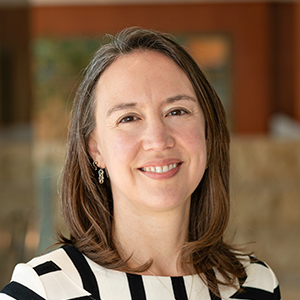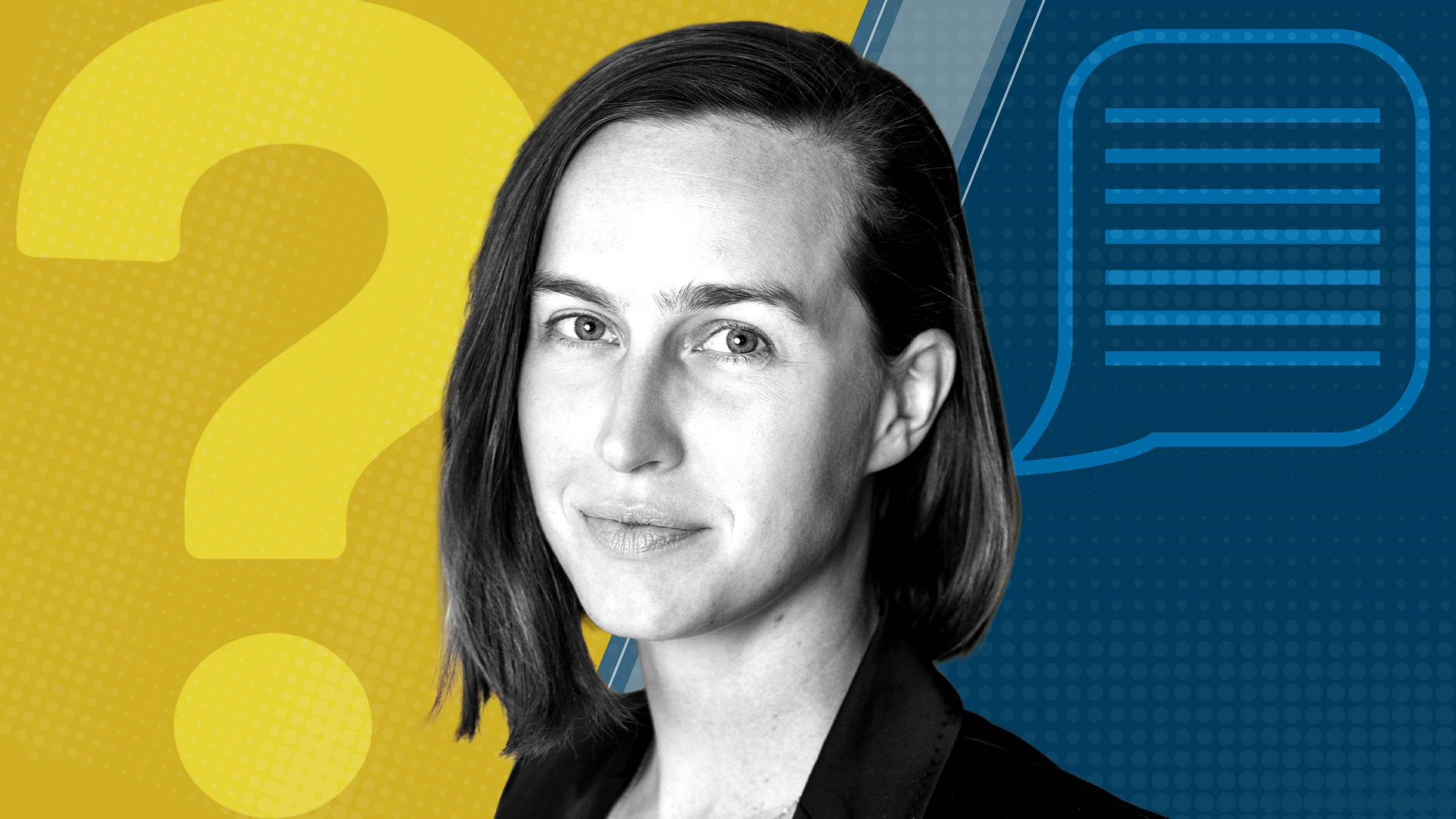The average age of retirement in the United States is around 63 years, while current average life expectancy is 76. That means that Americans can expect to spend around 13 years in retirement—almost 20 percent of their life. Put simply: Retirement is a long stage of our lives.
This, Institute consultant Mariacristina De Nardi explained at August’s Conversations with the Fed event, is a key reason she studies people’s economic behavior during retirement. And what could happen during retirement affects our decisions before we retire. My expectations around my health, living situation, and life expectancy all play into my decision-making about how long I will work and how much I should save. This matters at an individual level as well as an aggregate level and contributes to total labor force participation, consumption, and ultimately economic growth.
Of course, my expectations might differ from your expectations. As De Nardi, the Thomas Sargent professor of economics at the University of Minnesota, explained, average life expectancy at age 70 varies significantly according to a person’s health status, marital status, gender, and income—by as much as 11 years, in fact.
There is similar variation in a person’s risk of entering a nursing home. With a typical price tag of $100,000 a year for nursing-home care, uncertainty around my future needs creates a major risk that is difficult for me to “insure” against with my own savings: Either I save furiously for this low-probability but high-cost event, which runs the risk of my dying with money unspent, or I spend more now and run the risk of running out of resources, which will lower my quality of life.
And if that weren’t enough uncertainty to contemplate, the tumult of the past several years has introduced new variables into the economic equation of old age.
Most arresting is the toll on health and life expectancy, which dropped a staggering three years between 2019 and 2022. The loss of life has an immediate impact on those left behind: An estimated 450,000 Americans have lost a spouse to COVID-19.1 As De Nardi’s research shows, both the income and wealth of a couple that experiences the death of one spouse drop in the years before and after the death.
COVID-19 also forced many people out of the labor force, and new data from the Bureau of Labor Statistics shows that reemployment has been particularly low among workers over age 65. Nearly half of workers in this age group who had been with their employer for at least three years and lost their job in 2017 or 2018 were reemployed by January 2019. But for those in this group who lost their job in 2020 or 2021, only 28 percent were reemployed by January 2022. Not working reduces incomes and savings for those who would have returned to work if the pandemic hadn’t introduced new health concerns and upended the labor market.
The earnings prospects of younger generations have also become more uncertain, De Nardi pointed out, as millions of people lost jobs during the early phase of the pandemic and now the labor market is changing as technologies evolve. As a result, some older Americans may feel a greater need to help their middle-aged children and grandchildren financially, De Nardi said.
The economic tumult set in motion by the pandemic is also now contributing to higher inflation, introducing yet more uncertainty about how far savings will go. Rising prices are particularly burdensome for individuals on fixed incomes that are not completely indexed to inflation, as well as for households that spend a large fraction of their budget on necessities, which tend to experience greater price increases than discretionary spending categories do. What’s more, medical costs, a major spending category for older individuals, usually have greater increases than other prices for reasons that aren’t yet fully understood.
This is particularly true in the United States, where medical costs run as much as 25 percent higher than the same services in other countries, De Nardi said. Comparing how Americans organize public and private support for the elderly to the systems in other countries is a useful exercise because it allows us to identify the trade-offs and consider what an ideal system might look like. In northern Europe, for instance, high taxes typically pay for a high level of public insurance—and paying out of pocket for nursing-home care is rare. In southern Europe, networks of family and friends often play a large role. In the United States, these costs tend to be borne by individual households, and once those savings are depleted, by Medicaid.
To complement the Conversations with the Fed event, De Nardi answered additional questions about the potential implications to older households’ finances from these recent economic changes kick-started by the pandemic.
Your research points out that long life expectancies and the possibility of high end-of-life expenses mean that people keep saving far past retirement. If life expectancy starts to fall—due to COVID or perhaps other factors as well—how might this impact consumption and savings behavior?
Everything else equal, a shorter life expectancy means that people need to finance their living expenses for fewer years. In this case, if they do not have a strong desire to leave bequests, they will tend to consume more and save less for the future.
However, “everything equal” is a potentially unrealistic scenario, especially nowadays. For instance, life expectancy might drop, but the share of medical and other expenses that people must pay for might rise, due to rising medical expenses and costs of living. This might be partly due to rising price levels, coupled with less than perfect cost-of-living adjustments in retirement incomes, a situation that we might be currently facing.
In addition, many older people in the United States keep working, and they rely on that earned income to supplement Social Security, pensions, and other retirement income. If the shorter life expectancy comes together with a reduced capacity to work, people might want to cut consumption earlier on to save for the future, because they know that their future income will be lower, due to their reduced ability to work at older ages.
The infectious nature of COVID has meant a bigger impact on work for those who couldn’t work from home. This, too, points in the direction of lower, rather than higher, consumption.
In your research, you also point out that being widowed is a profound financial event that leads to a significant decline in household income. How might the loss of a spouse to COVID impact the surviving spouse’s financial planning?
The loss of a spouse at older age is an emotionally traumatic event that is also accompanied by big financial changes. First, retirement income drops on average by about 40 percent if the husband dies first and by 30 percent if the wife dies first. This largely reflects differences in their work history at younger ages as well as the nature of the marital and survival benefits that are part of Social Security and pensions.
Second, medical expenses jump in the period around death. We find that, typically, the out-of-pocket medical expenses of a couple in which there is a death are about $30,000 higher than for a similar couple in which there is no death.
Third, while a single household will in general spend less than a couple, many goods and services are less expensive when shared by two people. Most notably, there is now only one spouse living in the couple's house, which means that per-capita housing costs increase. In about 20 percent of cases, couples experiencing a death sell the house within two years. While this might allow them to downsize, it comes with a sizable liquidation cost.
Finally, having a spouse reduces one’s probability of entering a nursing home, which is a very costly proposition. Hence, losing one’s spouse increases the future medical expenses that one faces.
COVID might force some people to deal with these changes at a less-advanced age than they would have otherwise experienced. Hence, these individuals might have to cut their consumption and standard of living by more, in addition to having to deal with all these shocks and their emotional loss.
You’ve found that one reason being widowed decreases household income is it kick-starts giving wealth away. Because of COVID deaths among older people, that could mean that more “children” (people in their 40s and 50s and 60s) start receiving gifts from the surviving parent. On the other hand, if one parent dies earlier than expected and savings go down, there could be less for their children. How do you think these dynamics might play out?
COVID comes together with a period of higher costs of living and increasing uncertainty in the labor market. Increased costs of living affect people of all ages. More uncertain labor markets affect people who are still working. Thus, it also affects the “mature” children that you are mentioning.
COVID is also a “common shock” which has changed prices and the environment for everyone. In terms of health, the (permanent) increase in uncertainty about future individual health, and health expenditures, must be one of the key issues.
For these reasons, although it is too early to have hard data on this, I expect that many people will be even more cautious with their spending. I also expect that co-living arrangements between parents having lost their spouse and their children or other close relatives might increase because that allows them to live more cheaply and to have more support. That is, by co-living, an older parent gets more support and mature children experiencing labor market uncertainty have someone with a steady source of income under their roof. Of course, this is possible until the parent needs a lot of professional or institutional care.
Your research finds that consumption goes down when health deteriorates. COVID, and in particular, long COVID, seem like they could be such a health shock. What does your research say about how consumption might respond?
In my research based on pre-COVID data, we find that a negative health shock is associated with an increase in medical spending and a decrease in the consumption of other goods and services. We also find that this is because older people are less able to enjoy their consumption when they are sick. For instance, eating in a fancy restaurant might not be that appealing if you do not feel well, and hiking in an exotic location might not be desirable when there are mobility issues.
If older people having COVID recover from it, their drop in consumption due to this effect will be temporary. But if they have long-lasting effects from COVID, this might not be the case.
You’ve spent a lot of time studying consumption and savings behavior of older individuals. Given the shock of COVID to older individuals particularly, what could governments do to help older citizens?
That is the hardest question you have asked me so far. People who are currently old have grown up expecting the rules, shocks, and environment that were in place before COVID. COVID has been a large, unexpected shock, both for governments and their citizens.
Governments, both in the U.S. and in many countries have put in place many temporary support policies, both for citizens and firms, as a result of COVID. As a result of this [government support], of a secular increase in government spending, and of the economic contraction related to COVID, we now face large government debts and rising prices and interest rates.
When we consider a government intervention, we must carefully consider the costs of financing the policy as well as its benefits. COVID has been costly for society as a whole. This makes it more important than ever to evaluate all options and adhere to strong cost-benefit standards.
The views cited in this article do not necessarily reflect those of the Federal Reserve Bank of Minneapolis or the Federal Reserve System.
Endnotes
1 This estimate is based on total deaths due to COVID-19 reported by the CDC as of September 1, 2022, and the bereavement multiplier calculated by Ashton Verdery, Emily Smith-Greenaway, Rachel Margolis, and Jonathan Drew.
Lisa Camner McKay is a senior writer with the Opportunity & Inclusive Growth Institute at the Minneapolis Fed. In this role, she creates content for diverse audiences in support of the Institute’s policy and research work.






